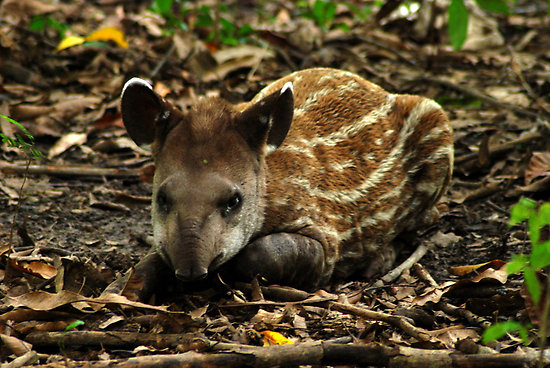
South American tapir(Tapirus terrestris)
Phylum —chordata
Class — mammalia
Order — perissodactyla
Family — tapiridae
Genus – tapirus
Appearance
Tapirus terrestris is dark brown, paler in the face, and has a low, erect crest running from the crown down the back of the neck. The round, dark ears have distinctive white edges. Newborn tapirs have a dark brown coat, with small white spots and stripes along the body. The South American tapir can attain a body length of 1.8 to 2.5 m (5.9 to 8.2 ft) with a 5 to 10 cm (2.0 to 3.9 in) short stubby tail and an average weight around 225 kg (496 lb). Adult weight has been reported ranging from 150 to 320 kg (330 to 710 lb). It stands somewhere between 77 to 108 cm (30 to 43 in) at the shoulder.
Habitat
The South American tapir can be found near water in the Amazon Rainforest and River Basin in South America, east of the Andes. Its geographic range stretches from Venezuela, Colombia, and the Guianas in the north to Brazil, Argentina, and Paraguay in the south, to Bolivia, Peru, and Ecuador in the west.
Behavior
Tapirus terrestris is an excellent swimmer and diver, but also moves quickly on land, even over rugged, mountainous terrain. Tapirus terrestris is known to run to water when scared to take cover.
Diet
The South American tapir is an herbivore. Using its mobile nose, it feeds on leaves, buds, shoots, and small branches it tears from trees, fruit, grasses, and aquatic plants.
Reproduction
Tapirus terrestris mates in April, May, or June, reaching sexual maturity in the third year of life. Females go through a gestation period of 13 months (390–395 days) and will typically have one offspring every two years. A newborn South American tapir weighs about 15 pounds (6.8 kilos) and will be weaned in about six months.
In captivity
It has a life span of approximately 25 to 30 years.
These animals are kept in large enclosures: for winter enclosures – 12 m, for summer – 30 m. The enclosure should be surrounded with a strong fence.
Tapirs need a reservoir of water where they will eat coastal vegetation and algae. Tapirs can be fed with concentrates, vegetables, fruits and grass.
 Russian
Russian
 English
English
























